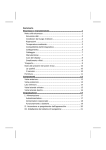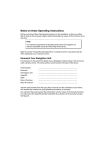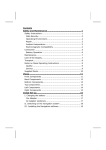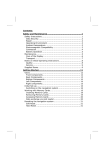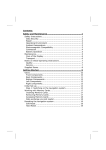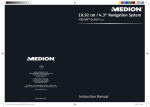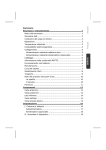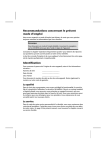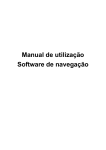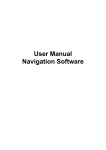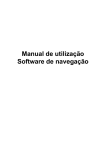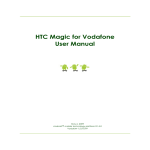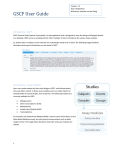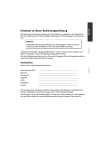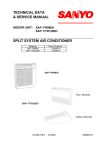Download user guide here - Sciuridae.co.uk
Transcript
Contents Safety and Maintenance .....................................................1 Safety Instructions............................................................. 1 Data Security .................................................................. 2 Operating Environment..................................................... 2 Repair............................................................................ 2 Ambient temperature ....................................................... 3 Electromagnetic Compatibility ........................................... 3 Connection ..................................................................... 4 Cabling .......................................................................... 6 Maintenance ................................................................... 6 Care of the Display .......................................................... 6 Recycling and Disposal ..................................................... 7 Transport ....................................................................... 8 Notes on these Operating Instructions .................................. 9 Quality........................................................................... 9 Service .......................................................................... 9 Supplied Items ................................................................ 10 Views ...............................................................................11 Front Components ........................................................... 11 Back Components ............................................................ 12 Bottom Components......................................................... 13 Left Components ............................................................. 14 Right Components ........................................................... 15 Initial Set-up....................................................................16 I. Power Supply ............................................................... 16 Car Adapter .................................................................. 16 AC Adapter (optional)..................................................... 17 Battery operation .......................................................... 18 II. Turning on/off the Device ............................................. 19 III. Installing the Navigation Software................................. 20 General Operating Instructions ........................................21 Working with Memory Cards .............................................. 21 Inserting Memory Cards ................................................. 21 Removing Memory Cards ................................................ 21 Accessing Memory Cards ................................................ 22 Data exchange via card reader ........................................ 22 Resetting the Navigation System (Reset)............................. 23 Navigation........................................................................24 Safety Instructions for Navigation ...................................... 24 Tips for Navigation......................................................... 24 Notes for Use in a Vehicle ............................................... 25 Additional Notes for Use on a Bicycle or a motorcycle......... 25 Aerial Orientation............................................................. 26 I. Mounting the Car Holder ................................................ 26 II. Fixing the Suction Plate ................................................ 27 III. Attaching the Navigation System .................................. 28 IV. Connecting the Car Adapter.......................................... 29 V. Starting the Navigation Software .................................... 30 MP3 Player .......................................................................31 Main Screen Overview ...................................................... 31 Select a Title and Move it into the List of Favourites ................. 33 List of Favourites ........................................................... 34 Picture Viewer..................................................................35 Operating the Picture Viewer ............................................. 35 Main Screen .................................................................... 35 Full Image View............................................................. 36 Travelguide (optional) .....................................................38 FAQ ..................................................................................39 Customer Service .............................................................40 First-Aid in the Event of Malfunction ................................... 40 General guidance........................................................... 40 Check Connections and Cables ........................................ 40 ii Faults and Possible Causes ................................................ 41 Additional Support ........................................................... 42 Appendix ..........................................................................43 Special CleanUp Function (Program management in English). 43 Synchronisation with the PC .............................................. 45 I. Installing Microsoft® ActiveSync® .................................. 45 II. Connecting with the PC .............................................. 46 III. Working with Microsoft® ActiveSync® .......................... 46 GPS (Global Positioning System) ........................................ 47 External GPS antenna .................................................... 48 TMC (Traffic Message Channel) .......................................... 48 Installing the External TMC Receiver................................. 49 Additional Card Material .................................................... 50 Transfer of card material to a memory card ....................... 50 Alternative Installation of the Navigation Software from a Memory Card ................................................................ 51 Transferring Installation Files and Map Material to the Internal Memory............................................................ 52 Mounting on (Bicycle) Handlebars ...................................... 53 Specifications ...................................................................54 Warranty ..........................................................................55 Liability limitations ........................................................... 56 Copying this manual......................................................... 56 Index ...............................................................................57 iii Copyright © 2007, All rights reserved. Microsoft®, MS-DOS®, and Windows are registered trademarks of Microsoft Corporation in the U.S. and other countries. Pentium® is a registered trademark of Intel Corporation. The names of actual companies and products mentioned herein may be the trademarks of their respective owners. Information in this document is subject to change without notice iv Safety and Maintenance Safety Instructions Please read this section carefully and follow all the instructions given. This will help ensure reliable operation and extend the service life for your appliance. Keep the packaging and the user instructions for future reference or inquiries at a later date. If you pass the article on to another person, you must pass on these instructions. • Never allow children to play with electrical equipment unsupervised. Children may not always correctly recognize possible danger. • Keep the packing materials, such as foil away from children. The danger of suffocation could arise in the case of misuse. • Never open up the housing of the appliance or the power adapter. These contain no user-serviceable parts. If the housing is opened there is a danger to life from electric shock. • Do not place any objects on the appliance and do not exert any pressure on the display. Otherwise there is a danger that the screen will break. • To avoid damage, do not touch the screen with sharp objects. Use only the stylus provided or another blunt implement. The device can also be operated with a finger in many cases. • There is a risk of injury if the display breaks. If this should occur, use protective gloves to pack the broken parts and contact customer support to arrange for disposal. Then wash your hands with soap, since there is a possibility that chemicals may have escaped. Safety and Maintenance 1 Remove the power adapter from the outlet, switch the appliance off immediately, or do not actually switch it on, and contact Customer Service... ... if the power adapter (optional) or the attached plug become scorched or damaged. ... if the housing of the appliance or the power pack becomes damaged or fluids leak into it. Components must be checked by Customer Service in order to avoid damage! Data Security • Every time you update your data make backup copies on an external storage medium. The supplier does not assume liability for data loss or damage to data storage units, and no claims can be accepted for damages resulting from the loss of data or for consequential damages. Operating Environment Failure to follow these instructions may lead to damage to your appliance. The guarantee will be excluded in such cases. • Keep your navigation System and all connected devices away from moisture and avoid dust, heat and direct sunlight, especially in the car. • Make sure you protect your appliance from getting wet, e.g. from rain and hail, at all times. Please pay attention that moisture can even build up in a protective pouch because of condensation. • Avoid heavy vibrations and shaking, such as can arise, for example, in the case of transverse field intrusions. • Avoid the device from releasing itself from its holder, for example when braking. Install the device as vertically as possible. Repair 2 • Please contact our Service Center if you encounter technical problems with your appliance. • In the event repair becomes necessary, please use only our authorized Service Partners. You will find the address on the back of your guarantee card. English Ambient temperature • The appliance is most reliably operated at an ambient temperature of between 41°F and 104°F (5°C and 40°C) and at a relative humidity of between 10% and 90% (noncondensing). • In the powered down state the appliance can be stored at between 32°F and 140°F (0°C and 60°C). • Store the appliance in a safe location to avoid high temperatures (e.g. when parking or from direct sunlight). Electromagnetic Compatibility • When connecting additional or other components the “Electromagnetic Compatibility Directive” (EMC) must be adhered to. Please also note that only screened cable (maximum 10ft) should be used with this appliance. • For optimal performance, maintain a distance of at least 10 ft. from sources of high-frequency and magnetic interference (televisions, loudspeaker systems, mobile telephones and so on. This will help avoid malfunctions and loss of data. • Electronic devices emit electromagnetic waves during operation. These emissions are harmless, but can interfere with other devices operated in close proximity. While our devices are tested and optimized for electromagnetic compliance in our laboratories, interference during operation may still occur in the device itself and with other devices in its proximity. Should such interference occur, try to eliminate it by adjusting the positions of and the distances between the devices. Before driving a car, please ensure that the electronic systems of the car are working properly. Safety and Maintenance 3 Connection When connecting your appliance be sure to correctly observe the following instructions: Power supply through Car Adapter • The car adapter should only be connected to the lighter socket of a car (car battery = DC 12V , truck battery = DC 24V !). If you are in any doubt about the power source in your car, contact your car manufacturer. Power supply through AC adapter 4 • The outlet must be in the vicinity of the appliance and must be easily accessible. • To disconnect your appliance from the power source, remove the mains adapter from the power socket. • Only use the mains adapter on sockets at AC 100–240 V~ AC, 50/60 Hz. If you are unsure about the power supply to the place of use, ask the relevant energy supplier. • Use only the power adapter provided with your appliance. • Do not cover the power supply unit, in order to avoid damage through unacceptable warming. • Stop using the power supply unit if the housing or the feed line to the device is damaged. Replace it with a power supply unit of the same type. • For additional safety, we recommend the use of a surge protector in order to protect your appliance from damage from spikes or lighting strikes on the power network. English Power supply by means of batteries Your device can also be operated with ordinary or rechargeable batteries. Battery Handling Batteries may contain combustible materials. Misusing them may cause battery leakage, heat, explosion or ignition, bringing about injury or damage to the product or YOU. Please observe strictly the following: • KEEP CHILDREN AWAY from batteries. • If by any chance, batteries are swallowed, consult a medical doctor immediately. • DO NOT CHARGE batteries (except rechargeable batteries). • DO NOT FORCIBLY DISCHARGE batteries. • DO NOT SHORT-CIRCUIT batteries. • DO NOT HEAT or DISPOSE OF IN FIRE. • DO NOT DISASSEMBLE or DEFORM batteries. Your hands and fingers may be injured, or the liquid of the battery may get into your eyes or adhere to your skin. If this happens, rinse with a large quantity of water immediately and consult a medical doctor. • DO NOT expose batteries to strong impacts by dropping or throwing the batteries. • DO NOT reverse the positive (+) and negative (-) terminals to avoid short-circuit. • REMOVE PROMPTLY any used battery from the device. • REPLACE THE BATTERY with a new battery of the same type. • INSULATE THE TERMINAL parts with tape or the like when storing or at disposal of the batteries. • DO NOT throw drained batteries in with the domestic rubbish! Respect the environment and dispose of them in the specific containers for separate collection. If necessary, turn to your reseller or to our service centre. Thank you! Safety and Maintenance 5 Cabling • Arrange cables so that no-one can tread on them or trip over them. • Do not place any items on the cable. Maintenance Warning There are no user-serviceable or cleanable parts inside the housing of the appliance. You can prolong the life of the appliance by taking the following simple steps: • Always remove the power plug and all connecting cables before cleaning. • Clean the appliance only with a damp, lint-free cloth. • Do not use solvents, caustic or gaseous cleaners . • The device and its packaging are recyclable. Care of the Display 6 • Avoid scratching the display surface as this is easily damaged. It is strongly recommended to use a display protection mylar to avoid scratches. Please ask your nearest dealer for this accessory. The foil on the display at delivery is purely for protection during transportation! • Ensure that no traces of water remain on the screen. Water can cause irreversible discoloration. • Use only a soft, lint-free cloth to clean the screen. • Do not expose the screen to either strong sunlight or ultraviolet radiation. English Recycling and Disposal Device At the end of its life, the appliance must not be disposed of in household rubbish. Enquire about the options for environmentallyfriendly disposal Batteries Do not dispose of used batteries in the household rubbish! They must be deposited at a collection point for used batteries. Packaging To avoid damage during transport, the PC is stored in a packaging. Packaging is produced mostly from materials which can be disposed of in an environmentally friendly manner and be professionally recycled. Safety and Maintenance 7 Transport If you wish to transport the appliance follow the instructions below: 8 • Following transport of the appliance wait until the unit has acclimatized before using it. • In the case of wide fluctuations in temperature or humidity condensation or moisture may form inside the appliance and this can cause an electrical short-circuit. • In order to protect the appliance from dirt, knocks and scratching, use either the protective case. • Before travelling ensure that you are aware of the power and communications provision at your destination. Before travelling obtain any power or communications adapters that may be needed. • When shipping your appliance use only the original packaging and advise the carrier accordingly. • When passing through the hand luggage control at airports, it is recommended that you pass the appliance and all magnetic storage media (external hard drives) through the X-ray system (the machine on which you place your bags). Avoid the magnetic detector (the structure through which you yourself pass) or the magnetic wand (the hand device that the security staff use), since this may corrupt your data. English Notes on these Operating Instructions We have structured these Operating Instructions for the installation so that you will be able to look up the necessary subjectrelated information by means of the Contents List at any time. Note You will find comprehensive Operating Instructions for navigation on the relevant CDs/DVDs and at the online help of the device. Read the section "Frequently Asked Questions" to obtain answers to questions that are often addressed to our customer service. The purpose of this manual is to help you with installing your appliance using instruction, that are easy to understand. Quality In selecting the components we have aimed for a high level of functionality, simple handling, safety and reliability. A wellbalanced hardware and software design allows us to offer you a technologically advanced navigation system that will give great satisfaction in both work and leisure use. Service Our individual customer care is there to support you when you have questions or problems. Please get in touch – we look forward to helping you. This manual contains a special section on Customer Service starting on page 40. Safety and Maintenance 9 Supplied Items Please check the integrity and completeness of the supplied items and, in the case this is not complete, forward us any possible claims within 14 days from the purchase date. The purchase package includes: • Navigation system • Power cable for cigarette lighter • Car holder • CDs/DVDs with navigation software • Support CD • Instruction manual and warranty card Optional 10 • AC adapter • Memory card MMC/SD • USB-cable • External GPS antenna • External TMC receiver • Bicycle fixture • Protective case / storage pocket English Views Front Components n q o Ref Component o p Description n Touch Screen Displays the output of your appliance. Tap on the screen with your finger, a stylus or a "blunt" tipped pen to select menu commands or enter data. o Selection but- To select a Menu point. ton and p Power indicator A green light will shine if the device is connected to and external source of electricity. This display will shine red in the case of a low battery status. The display will blink red if the battery status is critically low. q On-/Off button Press briefly to turn the appliance on or off (Suspend mode). Views 11 Back Components n GPS antenna o Ref Component Description n External Connection for an optional second GPS aerial. o Battery compart- Covers the battery compartment. aerial connection ment cover 12 English Bottom Components n o Ref Component Description n Reset Opening Restarts your appliance (Reset, see page 23). o Mini-USB- Connection for connecting to a PC by means of a USB cable (for data matching) as well as connection to external power supply. Connector Here you also have the possibility (optional) to connect a TMC receiver. Views 13 Left Components n o Ref Component n Earphone connector Description Connects to a pair of stereo headphones (3,5 mm). Using this appliance at full volume for extended periods of time may cause damage to the hearing capacity of the listener. o Loudspeaker 14 Plays back language statements and warnings. English Right Components n o Ref Component Description n SD/MMC Slot Accepts an optional SD (Secure Digital) or MMC (MultiMediaCard) card for removable storage. o Loudspeaker Plays back language statements and warnings. Views 15 Initial Set-up The following guides you step by step through the initial Set-up of the navigation system. Firstly, remove the foil for protecting the device during transportation from the display. I. Power Supply Car Adapter o n (similar picture) 1. Plug the jack (n) of the connection cable into the corresponding receptor at the bottom of your navigation system. 2. Insert the power adapter (o) now into the cigarette lighter socket and ensure, that it will not lose contact while driving. This could cause a malfunction. 16 English AC Adapter (optional) Adapter plug (similar picture) 1. Push the adapter connector into the guide on the back of the AC adapter. Press the push button at the same time, so that the adapter plug can engage. 2. Plug the cable of the mains adapter (n) into the mini-USB connection on the lower side of the navigation system. 3. Push the AC adapter (o) into a power point that is easily accessible. Initial Set-up 17 Battery operation Electricity is supplied by means of 4 AA type 1.5 V miniature batteries. 1. Open the battery compartment by pushing the battery compartment cover downwards. 2. Insert each battery into the battery compartment, paying attention to the correct polarity. - + + - - + + - 3. Close the battery compartment by replacing the cover and pushing it carefully back to the starting position. We recommend the use of alkali batteries for practical purposes. Operation with high capacity rechargeable NIMH batteries is also possible. Use a suitable charging device to recharge batteries. Batteries of this type cannot be recharged in the navigation system. The energy display may report a low energy status earlier, because a rechargeable battery displays a lower voltage than a normal battery. The device will start automatically as soon as you have inserted the batteries or the accumulators. Note Please read the information concerning the safe handling of batteries from Page 2. 18 English II. Turning on/off the Device Press the on/off button on the front side when you switch the device on for the first time. The Navigation System will start the initial installation automatically. The brand logo will appear and your device will display the application screen after a few seconds. Settings Navigation page 24 Travelguide page 38 Additional applications Additional applications MP3 player, page 31 Initial Set-up Picture Viewer, page 35 19 Note Brief pressure on the on/off button will be enough to switch the device on or off, provided that your navigation system is connected to an external source of electricity or is running in battery operation. The device will restart if the power supply has been interrupted for only a short time. No data will be lost during this because of the storage of data in the internal memory. The starting process will only last slightly longer. Your device will be delivered in a status in which it will not switch off independently. You can adjust the period of operation to suit your needs using the Settings button on the main screen of your device. Your navigation system will use a low amount of electricity and the batteries will be discharged, even when it has been turned off. It is possible for the battery to loose so much energy that an initial installation will be necessary once again, if you do not use the navigation system for a longer period. III. Installing the Navigation Software The final installation of the navigation software will take place automatically from the internal memory, during the initial setting up, if your device has already been equipped with the basic data of the navigation software at the factory. Follow the instructions on the screen. An optional memory card will always have to be inserted in the device during the use of the navigation system, if it contains digitalized map material. It will be necessary to carry out a Reset to restart the navigation system if the memory card has been removed, only for a short time, while the system was being used (see page 23). Please also read the chapter Navigation starting on page 24. 20 English General Operating Instructions Working with Memory Cards Your navigation system supports MMC and SD memory cards. Inserting Memory Cards 1. Carefully take the optional memory card out of its packing (if included). Take care not to touch or dirty the contacts. 2. Insert the memory card carefully into the card bay with contacts pointing forward. The printed side of the memory card must face upwards. The card must lock easily. Removing Memory Cards Note Only remove the memory card if the navigation software has been closed and the device has been switched off by means of the On/Off button beforehand. Otherwise you will risk a loss of data. 1. To remove the card press lightly onto the upper edge until it ejects. 2. Pull the card out without touching the contacts. 3. Store the memory card in the packing or in another safe location. Note Memory cards are very fragile. Take care not to dirty the contacts and not to force the card. General Operating Instructions 21 Accessing Memory Cards • The appliance only supports memory cards in the FAT16/32 file format. If you insert a card prepared with a different format (e.g. in cameras, MP3 players), your navigation system may not recognize it and will ask you to format it again. Warning Formatting the memory card irretrievably wipes out all data. Data exchange via card reader However, if you wish to copy large quantities of data (MP3 files, navigation maps) to the memory card, these can also be stored directly to the memory card. Many computers already have memory card devices. Insert the card in this and copy the data directly to the card. Because of the direct access you can achieve a much higher transfer rate compared to using ActiveSync®. 22 English Resetting the Navigation System (Reset) You will have the possibility of resetting your navigation system if it is no longer reacting or working properly. This option restarts the navigation system, without reinstallation being necessary. A reset is often used in order to reorganize the memory. In doing so all programs that are running are interrupted and the working memory is reinitialized. Choose this option if your navigation system is not responding or working properly. Perform the reset as follows: Insert a pointy object (e.g. a paper clip, which has been bent open) with slight pressure into the reset opening. The device will also restart if the external power supply is interrupted or the batteries/accumulators are replaced. General Operating Instructions 23 Navigation Safety Instructions for Navigation The bundled product CD/DVD contains a comprehensive instruction manual. Tips for Navigation • Do not manipulate the navigation system while driving to protect yourself and others from accidents! • In the event that you do not understand the voice instruction or if you are in any doubt about what to do at the next intersection, then the map or arrow display will provide you with a quick orientation. Only look at the display when you are in a safe driving situation! Legal remark The use of devices that warn for traffic monitoring systems (like „speed traps”) is prohibited in some countries. Please obtain information about the legal situation and apply the waning function only where allowed. We cannot be held liable for damages caused by the use of the warning function. Attention The road layout and driving rules take precedence over the instructions of the navigation system. Only follow the instructions when circumstances and driving rules permit it! The navigation system will guide you to your destination even when you have to deviate from your planned route. 24 • The direction statements of the navigation system given do not release the driver of the vehicle from his or her duty of care or personal responsibility. • Plan routes before you leave. If you want to plan a new route whilst on the road stop driving. English • In order to receive the GPS signal correctly, metal objects may not hinder reception. Attach the navigation system onto the inside of the windscreen or near the windscreen with the suction cup. Try out different positions in your vehicle in order to find the best reception. Notes for Use in a Vehicle • Take care that the holder does not present any risk to safety, even in the case of an accident, when installing it. • Take care that the cable does not impede any safety components. • The display of your navigation system may show “light reflections”. Please take care of not being “blinded” during operation. • Take care that the cable does not impede any safety components. • Do not mount the components within the operating range of any airbags. • Check the secure adherence of the suction cup at regular intervals. • The power plug will consume power, even if no device is connected. Remove it when not in use to avoid draining the car battery. • Check all safety equipment in your car after installation. Note Do not leave your navigation software in the vehicle when you leave it. You should also uninstall the holder for security reasons. Additional Notes for Use on a Bicycle or a motorcycle • Pay attention during installation that the ability to steer is not impaired. • Do not cover any instruments during installation. Navigation 25 Aerial Orientation The aerial must have unrestricted access to the sky to receive GPS satellite signals. Orient the aerial as horizontally as possible for this reason. Try out aerial and installation possibilities in the vehicle in the case of inadequate reception. It may be necessary to install an external GPS antenna (see page 48) under certain circumstances. I. Mounting the Car Holder Attention Only fix the holder for the navigation system to the windscreen, if it does not impede the view. Should this not be possible, then mount the holder with the suction plate in any way that will allow peril-free and safe operation. Snap-in lever Suction plate (optional) (similar picture) Note If you want to fix the holder to the wind screen, then you can skip steps 1 and 2. Note 26 English Your navigation system can also be equipped alternatively with another car mounting according to the version. 1. Remove the protective foil from the sticky side of the suction plate. 2. Fix the suction plate to a suitable location on the dashboard. Take care, that the surface of the dashboard is clean and press the suction plate strongly onto the surface. Note To obtain a strong and secure hold the suction plate should not be used for 24 hours. Note It cannot be excluded completely that certain plastics, strong solar radiation, etc. will affect or soften the adhesive strips and will be able to damage the surface of the dashboard through this. We shall not accept any liability for damage to the dashboard that may occur. 3. Connect the cradle to the car mounting. Pay attention to the inscription on the car mounting. The connection closes with a noticeable clicking sound (fig. see the next page). II. Fixing the Suction Plate Note Clean the disk thoroughly with a glass cleaner. Warm the disk and the nipple slightly at temperatures below 15° C. Place the holder with the suction head onto the suction plate (or directly onto the wind screen) and press the lever on the suction head downwards. The sucker will attach itself to the background firmly. Navigation 27 III. Attaching the Navigation System 1. Connect the car adapter (see page 16) and, if necessary, the external GPS aerial, to your navigation system and insert the memory card. 2. Place the holder on to the fixing holes and slide the holder to the left, until it engages audibly. 3. Attach the device to the holder by placing it below the holder and pressing it upwards, until it engages audibly. 4. Now you will be able to place the complete unit on the cleaned windscreen or the suction plate. holder cradle (similar picture) 28 English IV. Connecting the Car Adapter o n (similar picture) 3. Plug the jack (n) of the connection cable into the corresponding receptor at the bottom of your navigation system (p. 13). 4. Insert the power adapter (o) now into the cigarette lighter socket and ensure, that it will not lose contact while driving. This could cause a malfunction. Note Remove the power adapter from the cigarette lighter socket when ending a trip or when parking the car for a extended period of time. Otherwise the car battery could be drained. In this case use the power switch to turn off the navigation system. Navigation 29 V. Starting the Navigation Software Note Your memory card will always have to be inserted into the device during the use of the navigation system, if the card contains (additional) mapping material. It will be necessary to carry out a reset to restart the navigation system if the memory card has been removed, only for a short time, while the system was being used (see page 23). This Reset will take place automatically, according to the navigation system. 1. Switch on your navigation system. 2. The Navigation software will start automatically or after tapping on the navigation control button on the main screen, according to the version. 3. Tap on Navigation on the screen for entering the destination and enter the address of your navigation destination. Confirm your entry by clicking the 9 symbol to start the navigation. You will receive the route information on the screen, augmented by language statements, after a short time, if the satellite reception is adequate. Further information regarding the navigation software can be found in the comprehensive manual on your navigation CD(s)/DVD(s). This is a pdf-file you can read and print with the any Acrobat Reader. Note The GPS-receiver will require some minutes for initialization when deployed for the first time. Even when GPS signal reception is indicated the navigation could be imprecise. In all future instances it will take about 30-60 seconds until a correct GPS-signal is available, sufficient “sight” of the satellite is a prerequisite. 30 English MP3 Player Depending on the software equipment your navigation system is equipped with an MP3 player. Your navigation system is also equipped with an MP3 player. 1. Start the MP3 player from the main screen by tapping the ‘Further Applications, MP3 Player’ switch areas. Alternatively, the MP3 player can also be started from the navigation software itself. 2. All the MP3 files located on the memory card can be taken over into a List of Favourites and will be ready to be played. Main Screen Overview Button or Description Move to the previous or next file. It will be possible to skip backwards or forwards within the title playing while it is being played. Increase or decrease the volume. or The display in the upper right corner of the screen will show the current level of the volume. MP3 Player 31 Button Description For the title selection Opens the List of Favourites Play the playback. Pause the playback. Stop the playback. Changing the mode of playing: Normal: Plays all the files in their sequence and stops after the last file. Shuffle: Plays a file selected at random. Repeat: Repeats the current file continuously. Repeat all: Plays all the files in their sequence and will restart from the first file, after the last one has been played. Break off action / Back to the previous Menu Close MP3 player 32 English Select a Title and Move it into the List of Favourites Tap on and select the title that you would like to move into the List of Favourites, in order to select a title. You will have three possibilities of marking the title here: • , in order to mark all the titles, including all subTap on directories. • Tap on • Mark individual titles or remove the marking by pressing on it directly. , in order to mark all titles currently in view. The selected titles will be indicated by a . Tap on , in order to confirm your selection. The titles marked will not be moved into the List of Favourites until then. You will remove the marking of the title currently viewed with . Tap the file required and select the requisite title, in order to select a title in the sub-directories. You will arrive back at the superordinate directory with . The symbol will be shown if not all the titles in a directory have not been selected. MP3 Player 33 List of Favourites You will reach the List of Favourites by tapping on the You will delete individual titles with tles with : and you will delete all ti- . Confirm with , in order to take over the new selection into the List of Favourites. 34 English Picture Viewer Depending on the software equipment your navigation system is equipped with a Picture Viewer. You will be able to view the jpg format images on your memory card on your navigation system, with the Picture Viewer. All the images on the memory card will be available immediately. Operating the Picture Viewer Start the Picture Viewer from the main screen by tapping the ‘Further Applications, Picture Viewer’ switch areas. Alternatively, the Picture Viewer can also be started from the navigation software itself. Main Screen Ill.: Miniature view Move the miniature view to the left or to the right with both the arrow keys. Tap on a specific images, in order to display it in the Full Image Mode. The display in the upper right corner of the screen will show the current level of the volume. You will return to the start in the miniature view by tapping on You will end the application by tipping on the You will start the slide show by tapping the Picture Viewer . symbol. symbol. 35 Full Image View Ill.: Full image view without service strip Tap in the lower area of the screen in the full image view, in order to activate the service strip: Ill.: Full image view with service strip Button Description Previous picture Rotate by + 90° Fade in grid Start the slide show Pause the slide show Rotate by – 90° Next picture 36 English You will return to the miniature view by tapping in the centre of the image. The image displayed will be subdivided into 6 fields by tapping on the symbol (fade in grid). Ill.: Full image mode with grid The respective area of the image will be displayed as enlarged by tapping on a square: Ill.: Zoom-in Mode You will arrive back at the full image Mode by tapping in the centre of the image. Picture Viewer 37 Travelguide (optional) Depending on the software equipment your navigation system is equipped with a Travelguide. The Travelguide will supply general information about the different areas of individual towns and cities or regions in Europe, such as sights, restaurants, culture and travel information. Start the Travelguide from the main screen by tapping the ‘Travelguide’ switch areas. Alternatively, the Travelguide can also be started from the navigation software itself. Select the country initially, then the town or city (or the region), if you wish to be informed about something. Then, select the category. Luxembourg Germany Fig. 1 Fig. 2 Fig. 3 Fig. 4 Confirm with , if you want to navigate to the destination displayed. The address will then be available to the navigation software as the destination. You will be able to vary the possibilities of selection within the Travelguide, according to the software provided. 38 English FAQ Where can I find more informationen on the navigation system? Detailed operating instructions for navigation can be found on the corresponding CDs/DVDs, which accompany your navigation system. Also use the additional Help functions that are available with a single touch of a button (usually F1 on the PC), or by selecting the Help option, as additional assistance. These aids will be provided to you while you are using the computer or the device. What do I need the accompanied CDs/DVDs for? The Support-CD contains: • the ActiveSync® program for balancing data between the navigation system and the PC. • Additional programs (optional). • This User manual in digital form. Contents of the navigation-CD(s)/DVD(s): • digital maps • Data for rapidly resetting the contents of the memory card • Manual of the navigation software Depending on the configuration one or more CDs/DVDs may be included in the package. The navigation system is no longer responding. What should I do? Carry out a reset (see page 23). How can I adjust the lighting? Under Settings Ö Lightnings. FAQ 39 Customer Service First-Aid in the Event of Malfunction Error functions can sometimes have trivial causes; however, they can also sometimes be complex in nature and require costly analysis. General guidance Note The regular running of the Windows® programs “Defrag” and “Scandisk” on the PC can remove sources of error and raise system performance. Check Connections and Cables Start with a careful visual check of all cable links. If the LCD’s are not working, make sure that the power is reaching the computer and all peripherals. Note Switch off the computer and check all cable links. If the computer is connected to peripherals, check also the plug connections of all cables. Do not arbitrarily swap the cables between various units, even if they appear to be precisely the same. The pin assignments of the cables are likely to be different. Once you have ascertained that the power supply is not at fault and all connections are intact, switch on the computer again. 40 English Faults and Possible Causes The navigation system no longer reacts or is behaving atypically. • Carry out a reset (see page 23). The navigation system is recognized only as a guest by ActiveSync®. • See information on page 46. I am receiving error messages from a maintenance program after installing ActiveSync®. • The program places the WCESCOMM.LOG file in a temporary directory defined by the system, which cannot be deleted. A respective error message will appear, if another program attempts to do so. The GPS receiver cannot be initialized or found. If a GPS signal continues not to be reported on the screen, in spite of the correct installation of the system, this can be caused by the following factors: • Sufficient satellite reception is not possible. Solution: Change the position of your navigation system and ensure that unrestricted “sight” of the aerial is not impaired. No language statements can be heard. • Check the volume setting. Customer Service 41 Additional Support If the suggestions in the above section have not solved your problem, please contact our customer service hotline. However, before you contact your Technology Center, please have the following information available: However, before you contact your Technology Center, please have the following information available: 42 • How is your computer configured? • What additional peripherals do you use? • What messages, if any, appear on your screen? • What software were you using when the error occurred? • What steps have you already undertaken to solve the problem? • Have you upgraded or removed drivers or hardware? • Can you manually repeat the problem? • If you have been given a customer number previously, please give this number to the technician. English Appendix Special CleanUp Function (Program management in English) The CleanUp function serves the targeted deletion of data, without using a PC. IMPORTANT Please use this function very carefully, because it is possible for data to be deleted that will only need to be entered again manually afterwards. The CleanUp function will be activated if the ‘o’ is pressed in the Gopal lettering of the Main Menu briefly, immediately after the start tone following a reset. The CleanUp function offers 6 options: 1. Remove Installation Only Removes the software installed from the ‘My Flash Disk’ memory [= part of the permanent memory in which the executable parts of the navigation software will be located following the initial alignment (\My Flash Disk\Navigation)]. 2. Remove MAP Only Removes the digital maps from the ‘My Flash Disk’ memory (\My Flash Disk\MapRegions). Appendix 43 3. Remove Preload Only Removes the data needed for the installation of the navigation software from the permanent memory (\My Flash Disk\Install). 4. Remove All Deletes the whole contents of the ‘My Flash Disk’ memory. It will not be necessary to recalibrate the screen after this function has been carried out. 5. Factoryreset Sets the device back to the delivery status in the case of an intact main installation. 6. Format Flash Formats the internal ‘My Flash Disk’ memory. This formatting can be necessary in the case of a prolonged removal of errors. It will be necessary to recalibrate the screen after the formatting function has been carried out. All data will be deleted from the internal ‘My Flash Disk’ memory irrevocably, apart from this (see Remove All). Exit Leaving the CleanUp function and restarting the device (like reset) Note The deletion of the data must be confirmed before the action actually takes place. To do this, press on YES. There will be corresponding report if the data to be deleted are meanwhile (no longer) available. Please read the „Transferring Installation Files and Map Material to the Internal Memory“ chapter on Page 52, in order to recreate the files (installation files and map material) in the internal memory. 44 English Synchronisation with the PC I. Installing Microsoft® ActiveSync® In order to transfer your data between your PC and your navigation system you need the Microsoft® ActiveSync® program. The cost of the navigation system includes a license for this program which can be found on the Support CD. Attention Important files can be overwritten or changed during the installation of software. You should create a hard disk backup, in order to be able to have access to the original files in the case of possible problems following the installation. You must have administrator rights to install the software under Windows® 2000 or XP. Attention You should not connect the navigation system to your computer yet. 1. Insert the Support CD and wait until the program starts automatically. Note The Auto Run function is probably deactivated if it does not function. The Setup program on the CD must be started, to start installation manually. 2. Choose the language, click then Install ActiveSync® and follow the instructions on the screen. Appendix 45 II. Connecting with the PC 1. Press the On/Off button to start your navigation system. 2. Connect the USB cable to your navigation system. 3. Push the USB connector into a free USB port on your computer. 4. The hardware installation assistant recognizes now a new appliance and installs a suitable driver which can take some minutes. Repeat the die connection search if it fails the first time. 5. Follow the instructions on the screen. The program will now set up a partnership between your PC and the device. III. Working with Microsoft® ActiveSync® ActiveSync® will be started automatically if you connect your navigation system to the PC. The program will check whether the device is one with which a partnership has been entered. If this is the case, the changes that have taken place on the PC and on the navigation system since the last synchronisation will be compared and adjusted to each other. You will be able to define exactly which data will have priority during the synchronisation in the settings of the ActiveSync® Program. Call up the Help of the Program (with the F1 Button), in order to become familiar with the effects of the respective settings. A restricted Guest Access, with which you will be able to exchange data, for example, will become active automatically if the navigation system has not been recognised as a partner. If this is the case, although the process concerns the registered partner device, separate your navigation system from the PC and switch it off and on again. Now connect your navigation system to the PC, to restart the recognition process. Repeat the process and, restart your PC in addition, if your device continues to be recognised as a guest. Note: Make sure that you always connect your navigation system to your PC with the same USB connection, otherwise your PC will allocate an additional ID and reinstall the device. 46 English GPS (Global Positioning System) GPS is a satellite-backed system for determining your position. With the help of 24 satellites revolving around the earth, it is possible to determine your position on earth with the accuracy of a few meters. The satellite signals are received by the antenna of the built-in GPS receiver, which must have a "line of sight" to at least 4 of these. Note By limited line of sight (e.g. in tunnels, between houses, in woods or also in vehicles with metal-coated windows) it is not possible to determine the position. The satellite reception however automatically picks up again as soon as the obstacle has been passed and there line of sight is re-established again. Moving slowly (e.g. slow walking) also limits the accuracy of the navigation. The GPS receiver consumes additional power. This is especially of concern, when running on batteries. To conserve power do not turn on the GPS receiver unnecessarily. Also terminate the Navigation Software, if it is not needed or satellite reception is not possible for a longer period, for this reason. However, you can also switch the device off by means of the On/Off switch in the case of a shorter interruption to your journey. Pressing the same switch again will activate a restart. The GPS receiver will also be reactivated at the same time, if navigation software is still active. Here, it can take a short time for the position to be updated again, according to the reception situation. Note Please note, that your appliance is preset to not shut down automatically after a few minutes without activity. You can change this preset in the Settings mode. If the GPS receiver has not been active for some hours, it must orientate itself again. This process may take a while. Appendix 47 External GPS antenna This second optional GPS antenna makes it possible to receive the signals of satellites better (e. g. in the case of vehicles with a metallized windscreen). 1. The antenna should be pointing upwards. 2. Push the plug of the external GPS antenna into the opening provided for it (see page 12). TMC (Traffic Message Channel) The Traffic Message Channel (TMC) is a digital radio data service that functions in a similar way to RDS and is used to transmit disruptions to traffic to a suitable reception device. The traffic information is continuously transmitted across FM. The user is less dependent on the half-hourly broadcast traffic information, because the signal is continuously transmitted. Apart from this, important information, as in the case of people driving on the wrong side of the road for example, can be passed on immediately. The transmission is planned for the whole of Europe and is already offered by radio transmitters in many countries. The precision of the TMC messages can deviate greatly according to the country. The evaluation of TMC messages is not supported by every type of navigation software. Enquire whether your system supports TMC before the possible purchase of a TMC receiver. 48 English Installing the External TMC Receiver Please proceed as follows to connect your (optional) TMC receiver to your navigation system. 1. Connect the mini-USB plug to the mini-USB connection of your device. 2. Connect the projecting antenna to the TMC receiver and attach that antenna with the aid of the suckers, at the edge of your windscreen, for example. (similar picture) 3. Connect the TMC receiver to the car adapter cable after you have attached the TMC receiver to your navigation system. Your navigation system will now be able to receive traffic information through the TMC receiver and thus to avoid potential disruptions to traffic. Appendix 49 Additional Card Material Your navigation system is already equipped with digitalized map material in the internal memory and/or on a memory card at the factory. Depending on the configuration, additional maps may be included on your navigation CDs/DVDs. You will be able to transfer these cards to a memory card immediately. Here, it is recommended to use an external card reader (see also page 22). Depending on the amount of map data on the CDs/DVDs, memory cards with capacities of 256 MB, 512 MB, 1.024 MB or more may be required. You will obtain additional memory cards (MMC or SD cards) in specialist stores. Transfer of card material to a memory card The transfer of additional card material to a memory card will preferably take place through the Explorer of your PCs. Proceed as follows: 1. Insert the CD/DVD with the card material required. 2. Start your workstation and select your CD/DVD Drive. 3. Copy the file with the .psf ending out of the Directory of the region that you require to the MapRegions Directory on your memory card, from the CD/DVD. You can transfer several files with map material to your memory card, depending on the capacity of the memory card. There must be sufficient space on your memory card. If you have copied digitized maps of several countries or country groups onto your memory card, you will be required to select the desired map in the navigation application of your device. 50 English Alternative Installation of the Navigation Software from a Memory Card The software for your navigation system can also be installed directly from a memory card prepared accordingly The pre-installed software may have to be uninstalled beforehand (see special CleanUp function, Page 43). You will be requested to install the navigation software during the initial adjustment. Please proceed as follows: 1. Remove the memory card from the packaging carefully. Pay attention that the contacts are not touched or soiled. 2. Push the memory card into the SD-/MMC slot until it engages. 3. Click on OK, in order to install the application. The main screen, through which you will now be able to carry out the navigation settings, will appear after all data has been copied to your navigation system. Appendix 51 Transferring Installation Files and Map Material to the Internal Memory Note The navigation system must be connected to a computer by means of ActiveSync® (see Page 46), for the transfer of the data. Your device has an internal, permanent memory, which is located in the \My Flash Disk directory. You will be able to make this directory, and others, visible with ActiveSync®, by means of the Search option. Directories and files can be manipulated as in Windows Explorer. The required directory must have been stored, in order to make the installation files and the map material for the device available. Deposit the INSTALL directory for the installation files at (\My Flash Disk\INSTALL). Deposit the map material in the MapRegions directory (\My Flash Disk\MapRegions). Please pay attention to the modes of lettering given above when naming the directories. Pay attention to the fact that sufficient drive capacity must be available, if you have stored additional data on your navigation device. Remove files not needed if sufficient drive capacity is not available. 52 English Mounting on (Bicycle) Handlebars You can attach your navigation system to a bicycle as an optional additional feature. A special holder is needed to do this. The installation is explained in the following. Screws Hexagon key Clamp Holding plate (similar picture) 1. Release both the screws connecting the clamp to the holding plate with the hexagon key. 2. Remove the rubber ring and wind it around the handlebars. 3. Position the clamp on your bicycle handlebars, by pulling it across the handlebars from below. 4. Put the holding plate back onto the clamp and retighten both the screws. 5. Seat the holder for the navigation system on the holder plate until it locks into place audibly. Please pay attention to the fact that the holder must only be seated in one direction. 6. Now place the device on the holder. You must pay attention to firm positioning. Note Your navigation system could also be equipped with a different bicycle mounting, where the attachment of mountings can vary slightly, according to the version. Appendix 53 Specifications Parameter Information Power supply mains adapter KTEC KSAFB0500100W1UV-1 Input output Power supply cable for a cigarette lighter 100-240V~ 50-60Hz + 5V 1.0A max. Phihong CLA05D-050A Input output 12-24V, 1A max. 5V---1A Battery operation 4 miniature batteries (AA type, preferably alkaline) Earphones Stereo earphones (3.5 mm) Memory card type MMC and SD Connector type of the external GPS receiver MMCX USB interface USB 1.1 Dimensions 98 mm x 85 mm x 48 mm Weight approx. 185 g (without packaging /batteries) Temperaturen Operating Storage Humidity (without condensation) 54 10 – 90 % English +41 °F – +104° F (+5° C - +40° C) +32 °F – +140 °F -0° C - +60° C Warranty The receipt serves as proof of first purchase and should be kept in a safe place. Your legal rights are not limited by these warranty conditions. It is required should you need to make use of the guarantee. We guarantee that this equipment is in perfect working order. Upon production of the receipt, the remaining period of guarantee shall pass on from the original parts to the respective replacement parts. If you hand in this equipment to make use of the guarantee, you must remove all programs, data and removable storage media. Products which are sent without accessories will be replaced without accessories. The warranty obligation does not apply in the case of the problem being caused by an accident, a catastrophe, vandalism, misuse, incorrect use, ignoring the safety and maintenance regulations, changes by software, viruses or another piece of equipment or accessories or by other modifications not approved by ourselves. This limited guarantee declaration replaces all other guarantees of express or implied nature. This includes the guarantee of saleability or the suitability for a certain purpose but is not limited to this. In some countries the exclusion of implied guarantees is not permissible upon principle. In this case the validity of all express and implied guarantees is limited to the guarantee period. Once this period has expired, all guarantees become invalid. In some countries limiting the period of validity for implied guarantees is not permitted, so that the above limitation does not come into force. If you have any questions with regard to these guarantee conditions, please contact us. Warranty 55 Liability limitations The contents of this manual are subject to unannounced changes caused by technical progress. Manufacturer and sales shall not be responsible for any damages which have been caused as a result of omissions or errors in the information provided in this manual. Under no circumstances shall we be liable for any of the following: 1. Claims made against you by third parties based on loss or damage. 2. Loss or damage to your blanks, recordings or data. 3. Economic follow-on damage (including lost profit or savings) or associated damage even in the case that we have been informed of the possibilities of this type of damage. In some countries the exclusion or limitation of accompanying or follow-on damage is not legally accepted so that the above limitations do not come into force. Copying this manual This document contains legally protected information. All rights reserved. Copying in mechanical, electronic and any other form without the written approval of the manufacturer is prohibited. 56 English Index A F AC Adapter..........................17 Accessing Memory Cards .......22 Additional card material.........50 Aerial Orientation .................26 Alternative installation of the navigation software from a memory card ....................51 Ambient temperature ............. 3 Attach Navigation System......28 Auto run .............................45 Auto start............................45 FAQ ................................... 39 Faults and Possible Causes .... 41 First-Aid ............................. 40 Fixing the suction plate ......... 27 Front Components................ 11 G GPS ................................... 47 External GPS antenna ........ 48 H B Hotline ............................... 42 Back Components.................12 Bottom Components .............13 I Initial set up Battery operation .............. 18 Installing the navigation software ....................... 20 Power supply.................... 16 Switching on the navigation system .......... 19 Introduction ..........................9 C Cabling ................................ 6 Car Adapter .........................16 Card reader .........................22 Care of the Display ................ 6 CleanUp func .......................43 Connecting the car adapter ....29 Contents ............................... i Copying this manual .............56 Copyright .............................iv Customer Service .................40 L Left Components.................. 14 Liability limitations ............... 56 Loudspeaker ....................... 14 D M Data exchange.....................22 Data Security........................ 2 Defragmentation ..................40 Maintenance..........................6 Malfunction ......................... 40 Memory cards...................... 21 Microsoft® ActiveSync® ......... 45 Mini-USB-Connector ............. 13 Mounting the car holder ........ 26 Mounting the Navigation Set on a Bicycle ..................... 53 MP3 Player .......................... 31 List of Favourites .............. 34 E Earphones ...........................14 Electromagnetic Compatibility . 3 EMC .................................... 3 External aerial connection......12 External GPS antenna ...........48 Index 57 Main Screen Overview........31 Select title........................33 Safety instructions Batteries............................5 Navigation ....................... 24 Connection.........................4 Data security......................2 Operating environment ........2 Repair ...............................2 Power supply......................4 Cabling..............................6 Maintenance.......................6 Care of the display ..............6 Transport...........................8 Scandisk............................. 40 SD/MMC Slot ....................... 15 Selection button .................. 11 Service.................................9 Special CleanUp function ....... 43 Specifications ...................... 54 Starting the navigation software .......................... 30 Supplied Items .................... 10 Synchronisation with the PC .. 45 N Navigation Attaching the navigation system .........................28 Connecting the car adapter .29 Fixing the suction plate ......27 Mounting the car holder .....26 Safety instructions.............24 Starting the navigation software .......................30 O On-/Off button .....................11 Operating Environment .......... 2 P Picture Viewer Main screen ......................35 Operation.........................35 Power indicator ....................11 T TMC ................................... 48 Installing the external TMC receiver ........................ 49 Touch Screen ...................... 11 Transfer of card material to a memory card ................. 50 Transferring Installation Files and Map Material to the Internal Memory ............... 52 Transport..............................8 Travelguide ......................... 38 Q Quality................................. 9 R Recycling and Disposal ........... 7 Reinigungsmittel ................... 6 Repair ................................. 2 Reparatur............................. 2 Reset Opening .....................13 Resetting the navigation system (Reset) .................23 Right Components ................15 W Warranty ............................ 55 S Safety and Maintenance ......... 1 58 English






























































